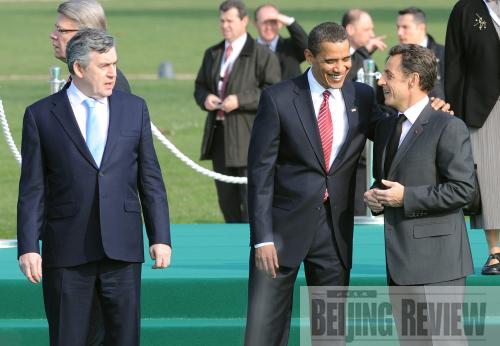|
 |
|
HOW'S IT GOING? French President Nicolas Sarkozy chats with U.S. President Barack Obama on the sidelines of the NATO summit in Strasbourg, France, on April 4, as British Prime Minister Gordon Brown looks on (WU WEI) |
NATO, which turned 60 on April 4, held its 24th summit in Baden-Baden and Kehl, Germany, and in Strasbourg, France, on April 3-4. In the 60-year history of the military alliance, its transformation over the past 19 years since the end of the Cold War has drawn the greatest attention. NATO is a product of the Cold War. When the Cold War ended, its existence came under serious doubt. However, the United States strongly called for preserving the alliance in a bid to prevent Russia from reemerging, enhance its influence in Europe and secure its global leadership. Under these new circumstances, NATO has introduced reforms to downplay its role in military confrontation and shift its focus to the new security threats confronting the international community.
Under pressure to perish following its rival—the Warsaw Pact, NATO is motivated to pursue reforms. But transforming such a huge alliance is never easy. Given its unchanged nature, reforms are confined within certain limits. A review of the key issues in NATO's post-Cold War transformation shows that the alliance has not abandoned its old ways despite some verifiable progress. Many of the pledged changes in its internal structure and external relations have yet to materialize. NATO's prospects are quite uncertain.
Futile reconciliation
After the end of the Cold War, how to redefine the position of Russia, the successor of the Soviet Union, became the central issue in the establishment of a new security order in Europe and the biggest challenge in NATO's reforms. In an attempt to foster an image of being committed to the peace and stability of the whole of Europe, NATO frequently sent messages of reconciliation and cooperation to Russia and other countries in the Soviet Union's sphere of influence. It not only issued statements with these countries vowing to build friendly ties but also initiated cooperative mechanisms at increasingly higher levels. For example, NATO and Russia set up diplomatic and military liaison and consultation institutions with each other. NATO promised to conduct equal consultations with Russia on issues concerning Europe's security. The United States and NATO have also cooperated with Russia on nuclear disarmament, disarmament of conventional weapons in Europe, antiterrorism and some regional hotspot issues.
Despite these positive developments, NATO has not replaced Cold War enmity toward Russia with political trust, respect and equality. NATO has a deep-seated conviction that they must guard against the possible reemergence of the "Soviet empire." While touting the rhetoric of friendship and cooperation, they have launched a series of diplomatic and strategic offensives against Russia.
First, NATO persists in expanding eastward despite Russia's protests. Disregarding the country's security concerns, NATO unilaterally stresses that all "European democracies" can apply for membership. Its relations with Russia have suffered a setback each time it admitted new members. At this year's summit, NATO reaffirmed its determination to continue expanding eastward. It also formally accepted two new members, Albania and Croatia. Conflicts may arise between NATO and Russia over this issue again in the future. Russia regards its neighbors Georgia and Ukraine as the last firewall against NATO's aggressive expansion. The two countries, which bear a deep grudge against Russia, are highly favored by Western countries. Their admission into NATO would lay bare the alliance's anti-Russian motives. Russia is categorically opposed to this and has vowed to protest more forcefully than ever. But the United States keeps encouraging NATO to admit the two countries. Their entry into NATO would have major repercussions for the security situation in Europe.
|
